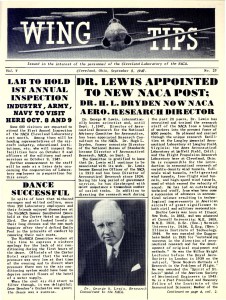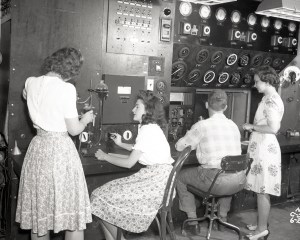In early January 1943, a technical library began operations at the NACA’s newly constructed Aircraft Engine Research Laboratory in Cleveland (now NASA Glenn). NACA researchers immediately began taking advantage of the library’s resources to support research into propulsion systems for the military aircraft used to fight World War II. The library, which has continually expanded its collection and the methods of accessing it, remains a vital research tool for NASA personnel 80 years later.
Head librarian Phyllis Snyder, who arrived at her post the day before the library opened, had spent the previous six months training at the Langley Memorial Aeronautical Laboratory and NACA Headquarters, where she began acquiring and cataloging books and documents for the Cleveland collection. She was soon joined by an engineer serving as reference librarian, a bibliographer with a chemical engineering degree, and a translator versed in 31 languages. These experts connected engineers to the information they needed for their studies.
The library, which was conspicuously located around the corner from the director’s office in the recently completed Administration Building, possessed an ever-growing collection of books, technical reports, journals, and basic reference materials.
Over the years the library also maintained building floor plans, technical specifications, and equipment manuals. In addition, arrangements were made so the NACA staff could borrow materials from other libraries, both local and at other federal agencies.
During World War II the collection was heavily stocked with fuels and lubrication materials. In the post-war years, the library acquired large numbers of Atomic Energy Commission documents to support nuclear propulsion research, as well as seminal texts on jet propulsion, materials research, and high-energy fuels. Later in the 1970s, the library housed large numbers of U.S. Department of Energy documents to support the center’s Earth resources research.
Snyder instituted a regular column in the laboratory’s newsletter to update researchers on new materials added to the collection, which doubled in size annually during the 1950s. In the early 1960s, the library began using early transistor-based computer systems to disseminate abstracts to employees for their literature searches. The automation reduced the request turnaround time from several weeks to just a couple days.
The center expanded dramatically in the early 1960s following the NACA’s incorporation into the new NASA space agency. In February 1966, the library was relocated to a much larger space inside the newly renamed Library Services Building. The new location provided two floors to house the library’s immense collection and new tools such as portable microfiche readers.
In the 1980s, the library introduced electronic cataloguing and checkout services that eliminated the need for a card catalogue. It also led the agency with the adoption of the Online Computer Library Center (OCLC) and Library of Congress standards.
As part of the center’s master planning process in the 2000s, the library was moved to its current home in the Research Analysis Center providing a modern reading room and access to massive amounts of materials, primarily electronic.
In 2022 NASA created the new History, Archives, and Library Division to improve the delivery of its library and information services.
Glenn librarians continue to connect researchers to the information they need to support NASA programs in aeronautics and space exploration, as well as performing new duties including competitive research and creating wikis for targeted fields.
Robert S. Arrighi
NASA Glenn Research Center




























